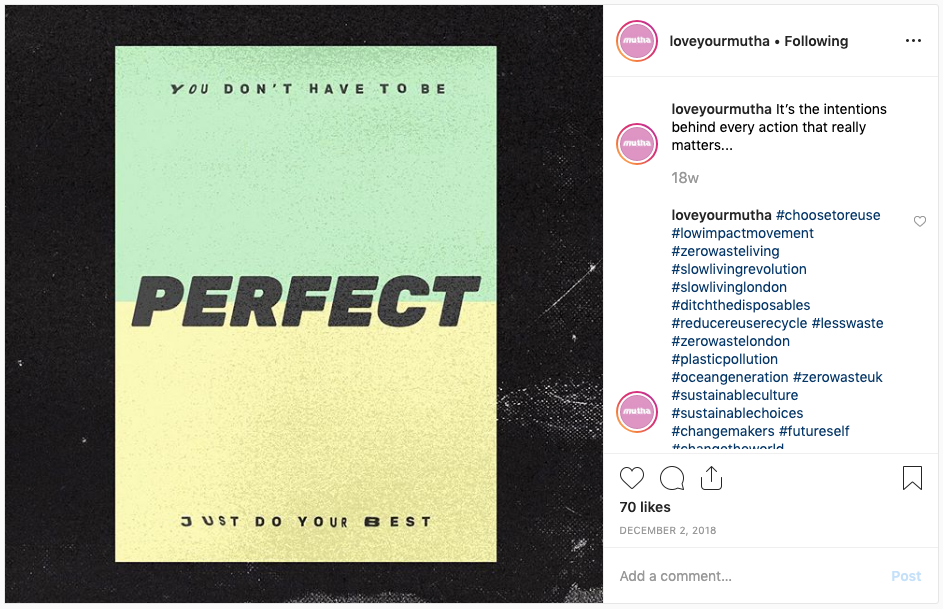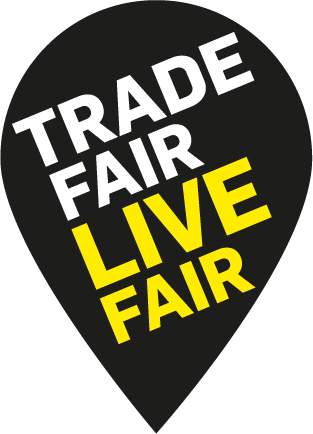This month’s Power of Influence takes us in a bit of a different direction. On a 15 minute walk from London Euston to London Kings Cross, Fashion Revolution co-founder Orsola de Castro and renowned fashion critic and columnist Sarah Mower spoke with Sara Arnold of Extinction Rebellion (and Higher Studio) about the recent protests, the aim of the movement and the next steps in their fight for climate justice. Shortly after this interview, the UK Parliament declared a climate change emergency.
A little bit of context: On Saturday April 27th, during Fashion Revolution Week and towards the end of Extinction Rebellion’s 2 week occupation of Central London, Slow Factory hosted “Study Hall: Sustainability as a Culture”. The event (in its first international edition) was held in London, UK. Before the event, the Fashion Revolution team along with Sara Arnold, Sarah Mower, speakers, attendees and supporters took a walk to discuss the current happenings.
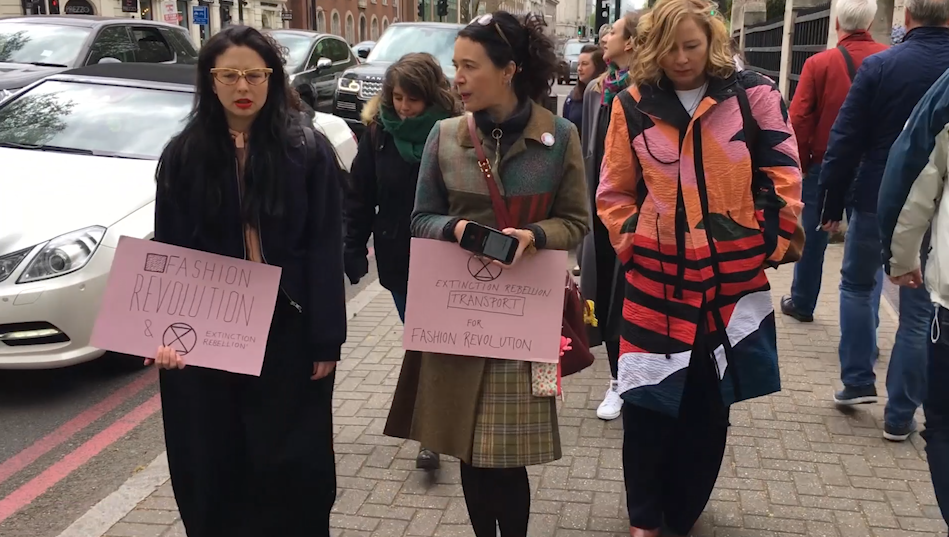
Here’s what was said:
Orsola de Castro: So the response to the protests… people are really prepared to put themselves out there. There were over 1000 arrests you say. Did you find that the overall response was positive?
SA: There has been criticism of the tactics used, there has been criticism of disruption, but that’s not we’re worried about. We want people to hear our demands, that’s what people should be focused on. I think we are making progress on that. Everyone is talking about climate change in a different way. Talking about it as an emergency. It doesn’t matter if they don’t agree with how we’ve gone about doing things. As long as it works.
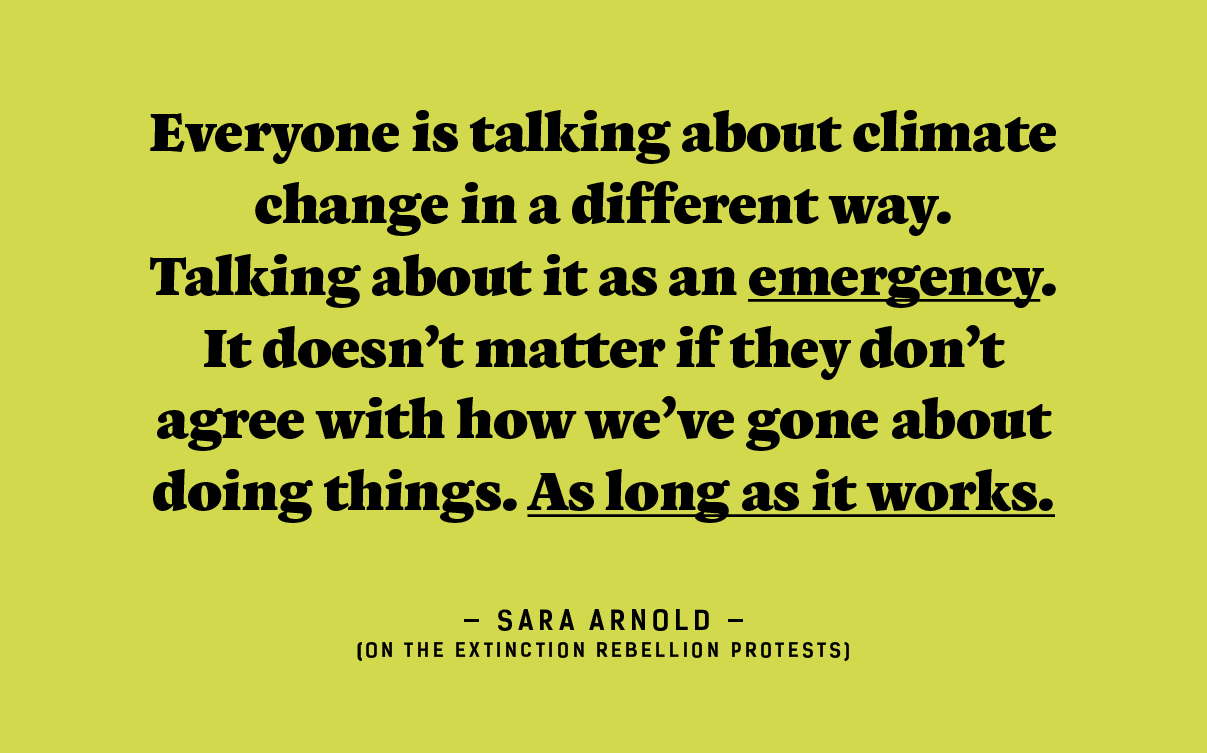
OdC: I’ve found that one of the reasons why we (Fashion Revolution) wanted to do this is the symbolism of joining hands. Even if everyone has a different way of doing things. The fact that the message is one of urgency is what we want to show. We need to all join together.
Could you tell me a little about how you guys started?
SA: Yes, so Extinction Rebellion were a group called Rising Up which started, in 2016, as a group of activists who wanted to theorise how they would go about creating this social change that we needed. They researched and put into practice different tactics. A member of Extinction Rebellion, Roger Hallam, who is currently doing his PhD at King’s College on these issues, one of the things he did was engage with an activist group at King’s that for years had been trying to get the University to disinvest from fossil fuel. They decided to stage a hunger strike. They were told that this process, even just the bureaucracy of disinvesting from fossil fuels would take a year to sort out. They said ‘okay, so let’s just try it’. So they went on hunger strike.
Sarah Mower: Because the university was investing in fossil fuels?
SA: Exactly. The whole process, from start to finish, from them going on hunger strike to all the investment coming out was 2 weeks. When they were told it would take years. So it just goes to show that direct action makes change. People do what they think is not possible when they are faced with disaster.
OdC: When I went to the first extinction rebellion meeting, you were talking about in war and in emergency, people make things happen. So the factories go from producing kitchenware to producing arms. When it is a state of emergency, historically, we’ve known citizens and organisations to take action pretty rapidly.
SA: Exactly. Now we have to get this declaration through to them so they can act.
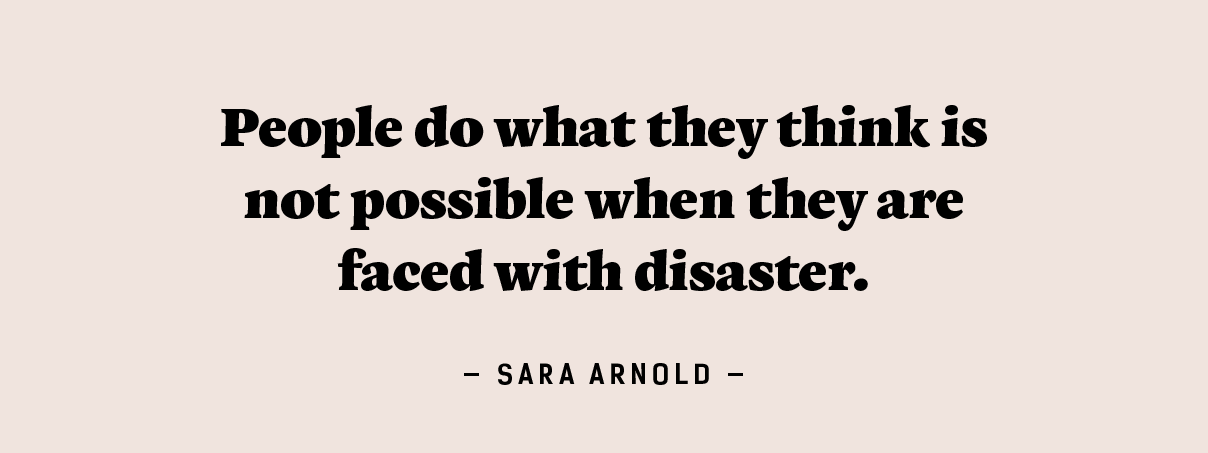
OdC: And so what about the involvement of Greta (Thunberg)?
SA: Greta was there when we held the Declaration of Rebellion on the 31st of October 2018. So we’ve had her support since the beginning. It’s really great that she came back at this time for the protests.
SM: She has changed everything.
OdC: She has changed everything.
OdC: You have other hubs in other countries, do you find there are other meaningful partnerships with local organisations in the rest of the world? Are you finding that people want to join you or do you find that they are hesitant to do so?
SA: The International Rebellion was in 33 countries. We have groups set up in 49 countries.
OdC: So like Fashion Revolution, you are de-centralised in the sense that it is volunteer run and people start their own groups.
SA: Yes. So we have 200 groups in the UK alone. The groups outside of the UK can have different demands to ours. They can adapt what we have done to respond to their own political situation. We’re so fortunate here to have police that are peaceful. And we have to use that privilege. We have a really engaged group in Ghana but if they did the same thing we are doing, they are looking at being arrested and then disappearing. It’s important for us to have solidarity with them. We keep a list of the names of those people so if anything does happen, we can protect them. It really interesting to get into that and see how we can help to take it further, internationally.
OdC: There are issues when you are a global group and you are dealing with law in different countries, even though the message is the same. Its important to recognise that.
OdC: How do you deal with citizens apathy out of fear? That people are so scared over what will happen, that they tend to go home and not know where to start.
SA: We need to really bring about this sense of urgency. That this is an absolute emergency. I feel its important to make people understand what the consequences are. We are talking about mass starvation, the death of billions of people if we reach a certain tipping point. Starvation is something we are really heading towards. We have 30 to 40 years left of fertile soil in this country, other countries are already hitting that. Let alone all the other problems. We are so dangerously close to hitting the tipping point.
Everyone is going to react to this differently. Everyone will go through a process of grief. And for a lot of people, grief will mean denial. That’s fine, you just have to feel compassion towards that. With extinction rebellion, what we are saying, is that when you give people the truth, a certain percent of the population, we think between 1 and 3% will rise up. And that is all we are aiming for. We need that 1 to 3% to rise up, to bring this to the governments and to take control.
OdC: And speak truth to power.
SA: Yes. We’ve been trying for the last 30 years to give people this positive message that we hope people will engage with and that great, but we don’t have time for that now.
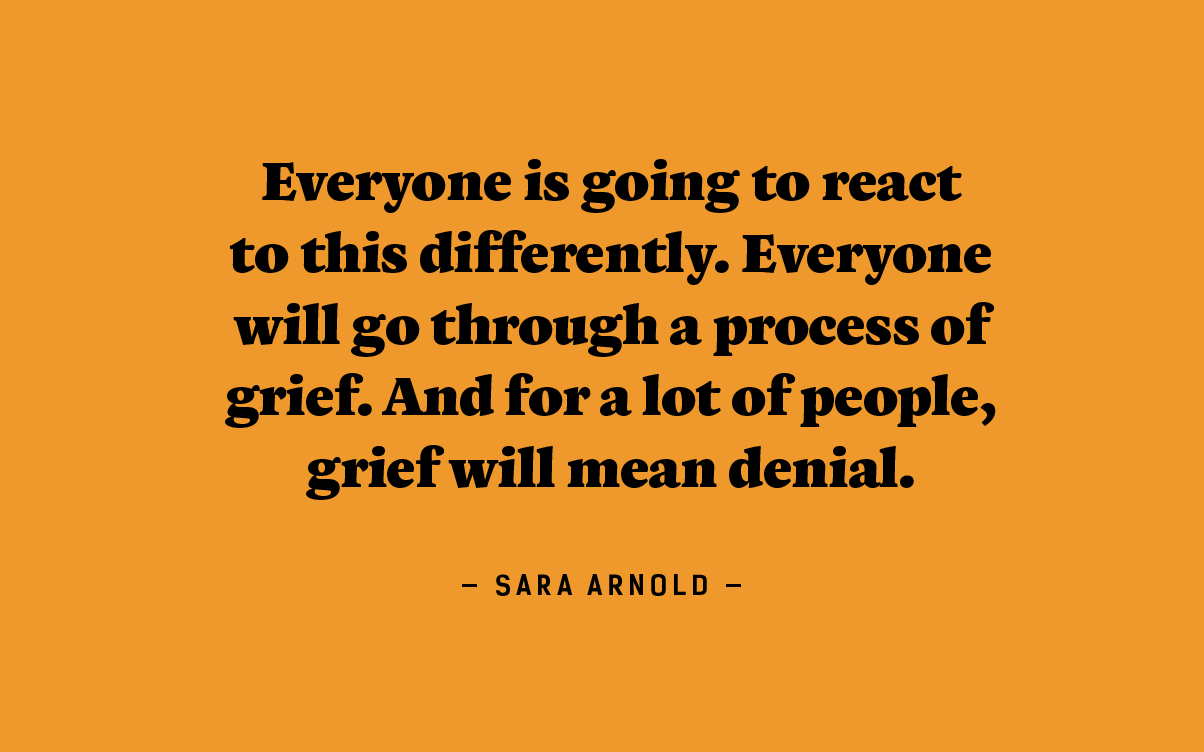
SM: So what do you think when Greta Thunberg stands in front of Michael Gove and he acts all Mea culpa. How do we hold him to account and get through real change?
SA: It’s a difficult question.
SM: If we’re talking about footfalls and governmental change.
SA: This is stage 1 of the rebellion. We can rise up and be bigger next time if we need to. I think. As we are doing that, we are waking people up to this emergency and its not something you can turn the clock back on. I think sooner or later the government will have to act.
OdC: I thought Mary Creagh was very honest at the recent Fashion Question Time when she was saying that we cannot do 2025 but working towards 2050, hoping it will gradually get faster and easier.
‘We aren’t going to get to net zero by 2025. The science will tell us what to do to get to net zero by 2050, and then in five years’ time to 2040 and then we’ll aim to get there for 2035. We have wasted the last 10 years, we’ve had no new policy in this country to change behaviour and we’ve done some policy mistakes along the way.’ Mary Creagh, Fashion Question Time at the V&A
SA: I think that we have to hit 2025. The Arctic is melting. We could lose it in a few years. That could be the tipping point that takes us into oblivion. We have to set our targets at something that seems impossible because then we are forced to look at system change. It is not about what we can do within the existing system, we have to look beyond that and listen to the science.
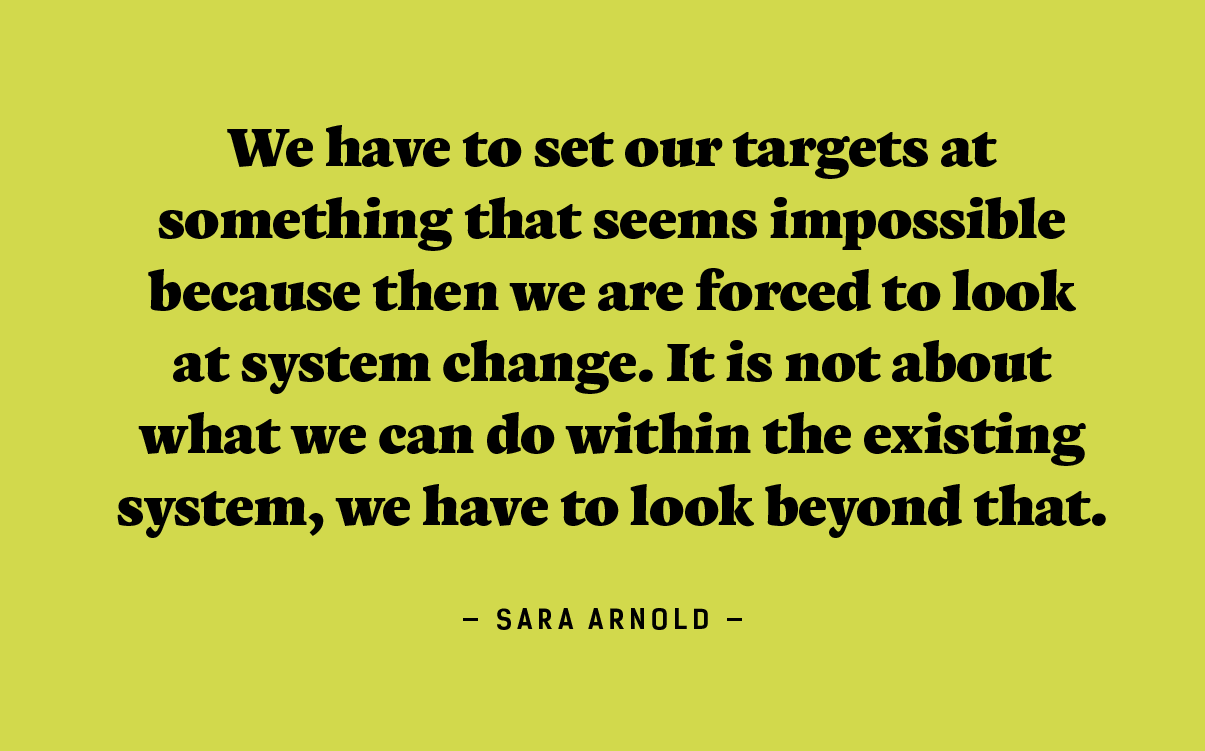
OdC: The science…the science corroborates that if we did stop now, it would get worse before it gets better.
SA: That’s the thing, pollution is currently cooling the earth. We are now 1.1 degrees warmer than we were during pre-industrial times. We need to keep ourselves below 1.5 if we are to avoid the most catastrophic consequences. BUT..If we slam on the brakes right now, the pollution will clear, causing an abrupt rise in temperature. This increase has been predicted to be between 0.5 and 1.1 degrees and so we may well have already used the carbon budget associated with 1.5 degrees of global heating. And that also puts us dangerously close to tipping points that will lead us into a so called ‘hot-house earth pathway’ of runaway climate breakdown. Its predicted that we reach this tipping point at around 2 degrees of global heating. Prof. Jem Bendell released a paper, ‘Deep Adaptation’, that puts together all the science to conclude where it is we are headed. His conclusion is that the collapse of civilisation is soon and inevitable. That immense catastrophe is likely and extinction possible.
‘I have chosen to interpret the information as indicating inevitable collapse, probable catastrophe and possible extinction.’ – Prof. Jem Bendell, Deep Adaptation: A Map for Navigating Climate Tragedy
So that is why we have to think about how we are going to adapt our culture, how we can reconnect with the thought of what it means to have a fulfilled life. What is important to us? This is why we say it’s not really about providing hope to people its saying we just need the courage to get through this and do what is necessary.
OdC: If we look at precedence, historically, the last time there was a massive mobilisation was in the 60’s. I often joke that the peace sign embroidered on jeans practically stopped the Vietnam war but it essentially sparked consumerism.
SM: Its true and now that generation, who are now grandparents, see their grandchildren protesting against it. It’s something I find very moving.
Further reading:
BBC: UK Parliament declares climate change emergency
Fashion Revolution Blog: Fashion Question Time at the V&A
The Guardian: Human society under urgent threat from loss of Earth’s natural life
Open Democracy: Britain just declared a climate emergency. What happens next?
IPCC: Special Report: Global Warming of 1.5 ºC
Life Worth: Deep Adaptation: A Map for Navigating Climate Tragedy
The Library: Study Hall: London Central Saint Martins
Check back every month for more in the Power of Influence series. We’ll post a new entry on the last day of each month throughout 2019. If you think there is someone we should be talking to, drop us a line on instagram.
We host Fashion Revolution Week in April of every year. This year kicked off on the 22nd of April. Throughout the week we encouraged people to ask brands ‘who made my clothes’ in hopes of shining a light on the unknowns of the fashion industry. By doing this, we hope to shift the focus from consumers to brands, and to all the hands involved, be it producers, workers, farmers or otherwise. We track the reach and impact of collaborators throughout Fashion Revolution Week and use the findings to fight for change worldwide, through government and policy. We are able to do this through the generous support of people like you. Please consider donating. Thank you.
Sparked by the buzz around HRH Meghan Markle choosing to shop amongst sustainable brands (yay), we found ourselves interested in learning more about the conscious and subconscious effect of social influencers and how that can shape our buying habits. Throughout 2019, we will be sharing our ‘Power of Influence’ series, talking to people within the fashion and social media realms about how they are using their platform for positive action. In this post, we celebrate Mutha.
Mutha are my favourite new source for all things sustainability. They not only have great fashion related content but they also delve in to other areas such as food, tech, sport and feminism. Their youtube channel is hosted by an insanely engaging team of presenters and their #relatable language and design aesthetic is something to be envious of. Current faves in their playlists include ‘Zero Waste Man‘ and ‘Black Friday Madness‘. To find out more about how it all happens, I chatted to Susan Adegboye, Mutha’s social media coordinator.
[youtube v=”6XqRPsULEnk”]
What is Mutha and how did it start?
So Mutha stemmed from wanting to celebrate the individuals and organisations operating in the world of food, fashion, travel and sport that are making a conscious effort to look after this planet of ours. We wanted to create a platform dedicated to the forward thinkers that were shifting the dial for a sustainable future, highlighting the importance of looking after the planet but without the scaremonger tactics.
Can you explain a little about the kind of content Mutha is creating to bridge that gap?
We tried to bridge that gap by including communities and groups that have previously never really been involved. A good example of this is SpAir Max Day, where we decided to tap into the sneaker community.
Coinciding with Nike Air Max Day on March 26th, we filmed a two-part series with renowned sneaker head Kish Kash, encouraging the sneaker community and a few household names such as Annie Mac, Clara Amfo and Leo Greenslade, to look into their vaults and donate some of their used, worn-in and probably landfill destined kicks to launch the first ever pop up sneaker shop where customers donate instead of buy. With the aim of collecting 1000 pairs of Air Max, cleaned by the team at Jason Markk and donated to the Brixton Soup Kitchen clothing and shoe bank.
We wanted to show the Mutha audience that upcycling and donating our used clothing and shoes not only has a positive impact on the environment, but that it can help people in our community in need. We wanted to work with the sneaker community to show how they can come together to do something good.
[youtube v=”ABaUzcJk33Q”]
I think thats a really interesting point – including communities that haven’t previously been part of the conversation. At this point, it feels like there is something everyone can do to play their part.
Exactly!
One of Muthas instagram post states ‘you don’t have to be perfect, just do your best’. Do you think there is a tendency to shame when it comes to issues of sustainability?
Nobody’s perfect and we all make mistakes, we’re human after all. It’s about what we do after the mistakes that really matters.
On that note, the team of presenters on Mutha feels very natural, honest, like they are part of the communities they interact with and they are experiencing the challenges and issues at the same time the audience are. Was it a conscious decision to work in this way?
Our presenters and the rest of the Mutha team, do not want to preach, but rather learn and share to inspire positive change. They represent the team behind the scenes who create the content and more importantly the audience who watch it. Our presenters come from varied backgrounds and have passions in totally different areas, but are all connected in the quest to learn and to live in a more sustainable way.
Thats definitely something that personally resonated with me when I first came across Mutha. It’s an inviting atmosphere. You sympathise and relate to the faces and voices you see and hear. Have you seen a positive reaction to this approach? Do your audience get it? Are they realising what they can do?
Ah we’re happy to hear that! At Mutha we believe that change has to start from within, we’re all on a journey here and in the 9 months since we started it we’ve all seen changes in ourselves and in our habits. The world of sustainability is often filled with doom and gloom, but a lot of us feel more optimistic now than we did before we started this journey. All the people that we’ve featured on our channel (and most of the feedback that we’ve received from our audience) is that Mutha feels like a celebration and inspires us to take the small actions that lead to big change.
So what does the future of Mutha look like?
The future of Mutha looks bigger and better, creating a lasting impact on an even wider scale. We hope that we can continue to provide a place where people can learn about sustainability and appreciating the world that we live in.
Thanks, Susan!
To keep up to date with all things Mutha, you can follow them on instagram and subscribe to their youtube channel. The second part of their two part SpAir Max Day initiative launched April 4th – see the video here.
Check back every month for more in the Power of Influence series. We’ll post a new entry on the last day of each month throughout 2019. If you think there is someone we should be talking to, drop us a line on instagram.
We host Fashion Revolution Week in April of every year. This year kicks off on the 22nd of April. Throughout the week we encourage people to ask brands ‘who made my clothes’ in hopes of shining a light on the unknowns of the fashion industry. By doing this, we hope to shift the focus from consumers to brands, and to all the hands involved, be it producers, workers, farmers or otherwise. We track the reach and impact of collaborators throughout Fashion Revolution Week and use the findings to fight for change worldwide, through government and policy. We would hugely appreciate it if you would be willing to share a story or celebrate a brand you love or simply ask #whomademyclothes during Fashion Revolution Week in 2019.
Sparked by the buzz around HRH Megan Markle choosing to shop amongst sustainable brands (yay), we found ourselves interested in learning more about the conscious and subconscious effect of social influencers and how that can shape our buying habits. Throughout 2019, we will be sharing our ‘Power of Influence’ series, talking to people within the fashion and social media realms about how they are using their platform for positive action. In this post, we talk to Ashley AKA bestdressed.
There is something different about Ashley’s videos. There is no big agenda, no preaching or bragging, no shaming when she talks about clothes. There is just this subtle little undercurrent of care and attention in the way she approaches her wardrobe. Thrifting, flipping (making new things out of old things) and the occasional scattering of self-deprecating humour makes for some exceedingly entertaining videos. Being an avid fixer and flipper myself, I wondered what made Ashley start working in this way and what effect, if any, she thinks it has on her audience.
Could you share your name and various media handles:
Ashley (aka bestdressed)
Youtube: bestdressed
Instagram: @best.dressed
Upon first glance, your youtube channel might seem like many others – OOTDs, clothing hauls and ‘day in the life of’s. When digging in though, your approach to sustainability through thrifting, upcycling and flipping your finds is totally ingrained into everything you do and say. For us, this is such an important and positive message to be spreading, something that others on the platform can seem to ignore. What made you start working in this way? Was sustainable fashion something you’ve always been conscious of?
I’m flattered, but honestly I never made a conscious choice to be a ~hero~ of sustainability! My love of thrifting and tendency to rewear clothes really comes from a financial perspective. When I was a younger, I never liked thrifting, My sister would always find gems, but I’d get bored and frustrated 15 ugly sweaters in and go play Doodle Jump in a corner. But two summers ago, when was in full on chipmunk mode post-wisdom teeth removal, I needed something to pass the time before my cheeks deflated. Lo and behold, I decided to go thrifting, and finally found some cool stuff. From that point on, I was obsessed – mostly because at that point I was still working for $8 an hour at an ice cream shop and could use the cheapest clothes I could get. Plus, I was about a year into my (vastly unsuccessful at that point) YouTube career. I would post a haul or OOTW here and there, but I could never seem to keep up with other girls who would have five completely new outfits each week. Thrifting, for me, was a way to experiment with my style and make interesting content, and rewearing clothes for years (even “fast fashion” clothes from Forever21) was just a product of not having that much money.
In a lot of your videos you alter, adjust, flip your existing clothes (or second hand clothes) into something totally new. Do you think it’s something everyone could and should be doing? Does this satisfy the itch to own something new, without playing into the fast-fashion world?
For me, it’s even better! It’s like Marx’s theory of alienation from the work product, right? There’s something so satisfying about making or altering something yourself. Every time you look at it or wear it you get to be like “Damn! I did that! And nobody else has anything like it!” I know everyone’s not the craftiest or has time to alter their clothes, but I hope I can encourage people to at least give it a try! Something as simple as patching up a hole instead of throwing a shirt out, or cropping an old t-shirt are a great place to start!
Do you feel the pressure from brands to buy? Do you think it’s possible to stay fashionable without buying in excess?
Absolutely. That’s the whole job of the marketing industry. And now social media is overtaken by the marketing industry. So every day, tons of images and videos are telling you that you want new things. Honestly I fall victim to this too. It’s usually only when I’m bored or procrastinating or feeling shitty, but I’ll go into this fervor of opening tabs and adding items to my cart. Normally the total price at checkout stops me though, haha. I don’t go to malls anymore because they make me crazy. Literally my brain just goes: clothes! clothes! more clothes! I sound insane but I swear this probably happens to a lot of us. Luckily, a lot of what’s “fashionable,” at least for a certain segment of internet hipsters, is shifting towards thrifted and vintage clothes. I love that it’s cool now to wear an old oversize t-shirt or a vintage linen dress. Since my entire job revolves around fashion, I do still buy new clothes, but I always think about my purchases thoughtfully and try to mix in thrifted, vintage, sustainable, and altered clothes.
Do you see an uptake in responsibility from your followers when you share content that focuses on sustainable issues? Do their responses show that they’re thinking differently about what they buy and how they buy?
Honestly unfortunately I think it’s a bit of singing to the choir when it comes to sustainable vs. fast fashion. There are still crazy amounts of $300, $500, $5000 Wish/Zaful/Shein hauls online, with audiences willing to watch. I’m chillin over here in my corner of the internet with gals who already love thrifting. And who’s reading this article? Surely people who already care about sustainable fashion. Perhaps that’s just me being a bit of a pessimist. In the long run, I think sustainable content can change how people think, but it takes time. I hope that at least some people who have subscribed to my channel from a fashion video have found their way to a thrift haul, and after watching a couple, have tried thrifting on their own! And maybe my thrift flips makes fellow sewing nerds like me feel a little cooler lol.
Okay now for some quick ones…
- Current favourite piece in your closet?
A sherpa jacket I thrifted from the men’s section! So cozy and looks like it cost a fortune - Do you remember the first piece of clothing that you ever bought for yourself?
A gray American Eagle hoodie in 6th grade - Do you still have it?
I wore it nearly every day to school for 3 years (I was one of those kids) but we had to part ways after it was pretty much falling apart. - Do you know who made the clothes you are currently wearing?
My top is thrifted (so not sure who made it originally) and my jeans are Redone vintage Levi’s made in the US. - Top tip for others wishing to shop more responsibly?
Start with browsing a vintage or thrift store, finding a few quality sustainable pieces to invest in, looking through your own closet to find old gems you forgot you loved… or even remembering to return items you don’t end up loving – that’s a huge one! It’s so easy, you get your money back, and you don’t end up with clothing sitting in the back of your closet. You’d be amazed by how many people buy stuff and can’t be bothered to return it. I think sustainable culture can be a bit intimidating and make you feel guilty for your past purchases or if you aren’t perfectly sustainable at the start. It’s all about starting small – even if you just stop and think about one fast fashion purchase per month, that’s still awesome!
Thanks, Ashley 🙂
Check back every month for more in the Power of Influence series. We’ll post a new entry on the last day of each month throughout 2019. If you think there is someone we should be talking to, drop us a line on instagram.
We host Fashion Revolution Week in April of every year. This year kicks off on the 22nd of April. Throughout the week we encourage people to ask brands ‘who made my clothes’ in hopes of shining a light on the unknowns of the fashion industry. By doing this, we hope to shift the focus from consumers to brands, and to all the hands involved, be it producers, workers, farmers or otherwise. We track the reach and impact of collaborators throughout Fashion Revolution Week and use the findings to fight for change worldwide, through government and policy. We would hugely appreciate it if you would be willing to share a story or celebrate a brand you love or simply ask #whomademyclothes during Fashion Revolution Week in 2019.
Sparked by the buzz around HRH Megan Markle choosing to shop amongst sustainable brands (yay), we found ourselves interested in learning more about the conscious and subconscious effect of social influencers and how that can shape our buying habits. Throughout 2019, we will be sharing our ‘Power of Influence’ series, talking to people within the fashion and social media realms about how they are using their platform for positive action. First up is Arden Rose.

I was recommended Arden’s youtube channel by Youtube itself (thanks algorithms). Finding a funny, interesting AND socially, environmentally conscious human who also creates entertaining content is pretty rare, right? Exactly. I was hooked right away, and with 1.4 million youtube subscribers and coming up to 900k followers on instagram, I wasn’t the only one. My first point of call was watching the fantastically titled ”how to NOT destroy the planet while shopping“. There were many questions I wanted to ask, much admiration I wanted to share. So…after a quick binge of other videos, and a swift click of the subscribe button, Arden became the first in this series of interviews. Her answers didn’t disappoint. Read on, read on…
To start, could you share your name and various media handles:
@ardenrose on everything!!
In a community of hauls, where buying in excess and presenting that image to the world is commonplace, you choose to do differently. We think that’s totally awesome and also pretty brave. Was it hard for you to step away from the established way of working and suggest a different way of doing things?
It was hard in the sense that hauls tend to do well on YouTube and they’re easy (i.e. unoriginal) content to make. Honestly, buying that much junk was tiring, it filled up my closet with trendy pieces I don’t want in a month, and it was boring to make. I’m so much happier to share clothing that I had to hunt or search for to make it sustainable and worth showing on my channel! Honestly, everyone should give themselves the challenge of not relying on constantly selling their audience on cheap slave labor. Definitely helps me sleep (slightly) better at night.
Your video ‘how to NOT destroy the planet while shopping’ is SO well informed and honest and great. You mention other youtubers who inspired your choices. Do you think more people on the platform need to be addressing these issues?
ABSOLUTELY. It shocks me that people can just turn a blind eye to the obvious pain they allow corporations to get away with or ignorantly support. Everyone should be promoting sustainable business practices, especially the women on the internet that tend to to push fast fashion as a “cheap” and “easy” alternative to a constantly refreshing industry like the fashion industry. Viewers should be educated, but at the very least the entertainers who are preaching to them should be educated.
Have you always been a conscious consumer or was there a moment when the switch flipped and you started to think more about the way you buy?
I touch on this briefly in my “how to NOT destroy the planet while shopping” video, but I used to make H&M and Forever21 hauls allllll the time. Constantly. My channel was filled with that shit. Fortunately I sat down and watched all the necessary documentaries and read all of the articles late last year and completely got my stupid self educated on the issue. Honestly, I always KNEW that fast fashion was bad business, but I was wilfully ignorant so that I didn’t have to give up my shopping addiction that felt baked into my personality.
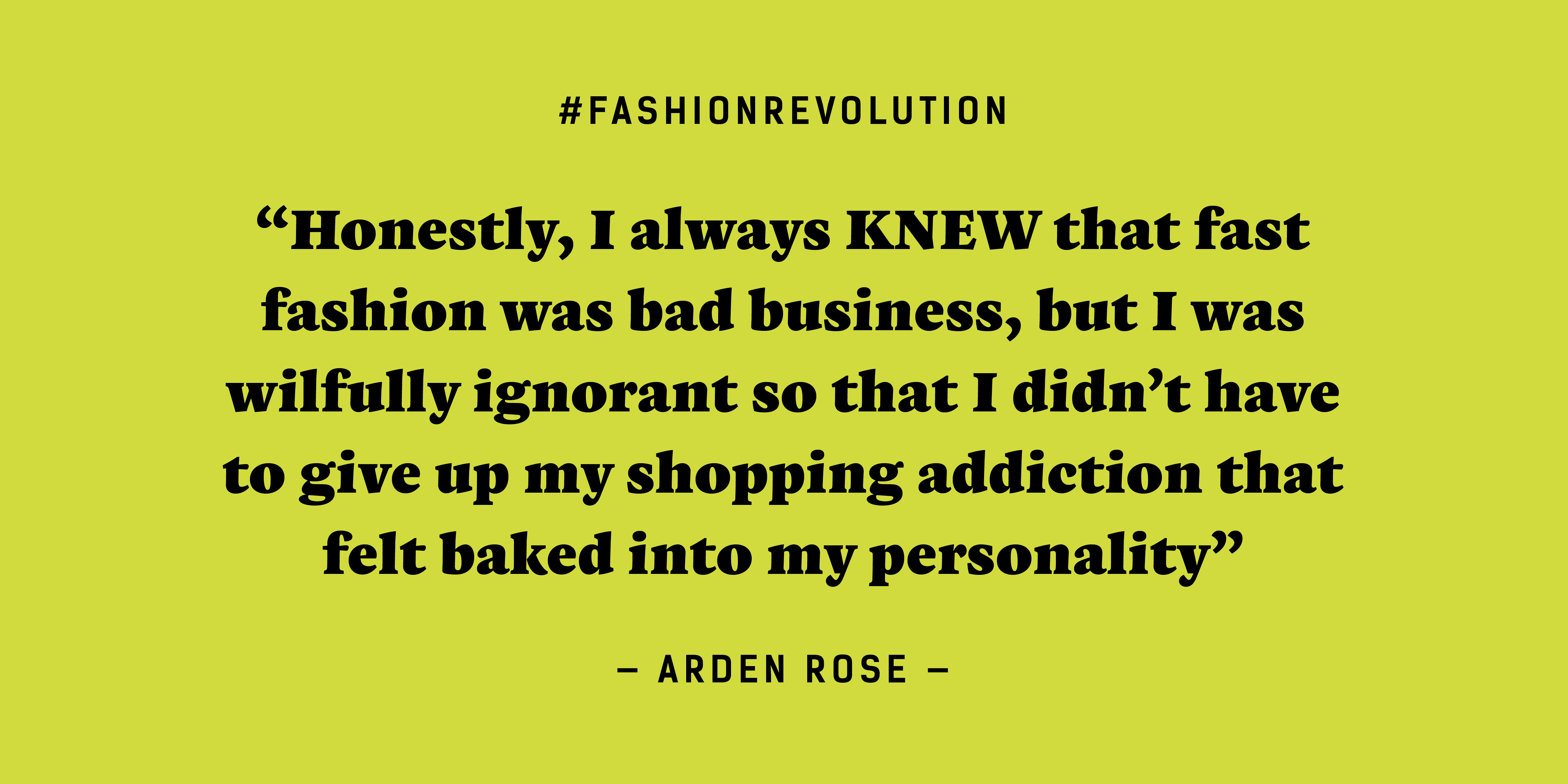
Do you see an uptake in responsibility from your followers when you share content that focuses on sustainable issues? Do their responses show that they’re thinking differently about what they buy and how they buy?
Yes!! And that’s what’s so amazing to me! I don’t even have the largest audience but I get hundreds of comments about my sustainability video a week. I didn’t even think that many people saw it! Nowadays, consumers want to be in the know, and they want clear consciences. Having a friend on the internet (me!) sitting you down and calling you out on the way you’ve been spending your money is helpful and doesn’t feel accusatory! It feels like friendly advice which is important. A lot of people get turned off of the sustainability conversation because it sounds preachy. You need to be a friend to these people, not a holier than thou asshole. I like to think I’ve helped a lot of young women and men rethink their spending habits when it comes to fashion, but I also think it’s just the power of a younger generation that actually cares about others and the planet! They’re awesome and so fired up for change!
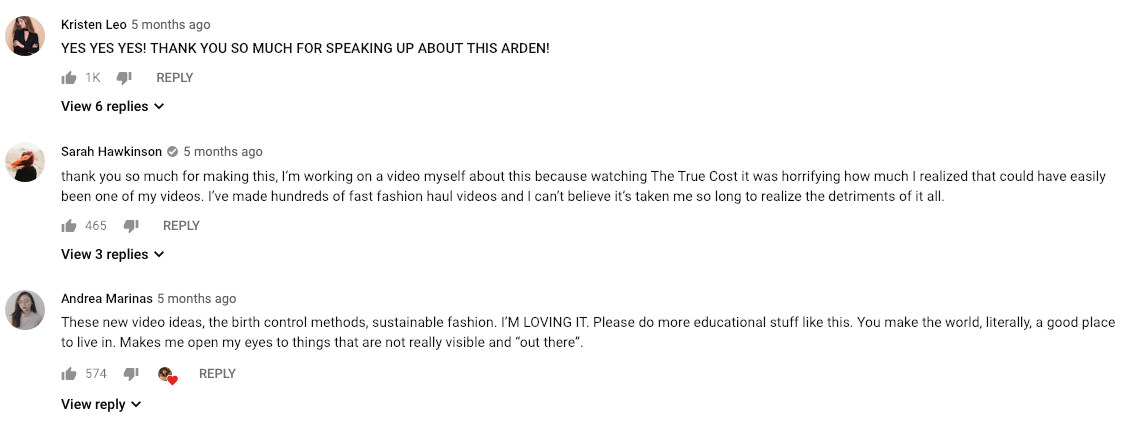
Do you think it is easy to find and share information about the sustainability of fashion brands and the effects of fast fashion on people and planet? Is there anything you can think of that would help make it easier to do so?
It is easy if you want to find it. It would be easier if large publications and fashion houses made it a priority to promote the message. It doesn’t benefit the industry to reveal its ugly underbelly, so they try to hide it, or dangle a carrot in your face via a “sustainable line” that only happens once in a blue moon. If there was a grassroots coalition of the top fashion bloggers and instagram baddies calling these companies out and only promoting sustainable brands, I can bet you big money things would shift in a major way.
Okay now for some quick ones…
- Current favourite piece in your closet?
A brown corduroy button down dress from Paloma Wool that I bought recently. - Do you remember the first piece of clothing that you ever bought for yourself?
I would have NO idea and I find that sad. It was probably a tee-shirt from Target if I’m being honest. - Do you still have it?
Definitely not. - Do you know who made the clothes you are currently wearing?
Yes! A small company in Denmark knitted my sweater, my tee shirt is of my own design and is produced sustainably in Canada, and my leggings are from an activewear company that produces everything in a mom and pop shop out of Italy. Wearing a very well traveled outfit right now hahaha. - Top tip for others wishing to shop more responsibly?
Unless a brand *explicitly* advertises that it’s sustainable, be skeptical, and even if they do, remain skeptical. Educate yourself. We have the internet now and have 0 excuses to be ignorant! If you question the sustainability of a brand, do a quick google search before committing to the purchase. It’s true that sustainable fashion tends to be a bit pricier but just think about all the hands that it took to create the piece you’re holding and the people they belong to that are being paid well and treated with respect because you’re willing to treat your closet with respect. We don’t NEED an abundance of new clothes every season, we’ve been duped by an industry that only has money in mind. You don’t have to have the latest trend in your closet, you can re-wear clothes until they fall off your body, and anyone who judges you for your lifestyle is slow on the uptake.
Thanks, Arden 🙂
Check back every month for more in the Power of Influence series. We’ll post a new entry on the last day of each month throughout 2019. If you think there is someone we should be talking to, drop us a line on instagram.
We host Fashion Revolution Week in April of every year. This year kicks off on the 22nd of April. Throughout the week we encourage people to ask brands ‘who made my clothes’ in hopes of shining a light on the unknowns of the fashion industry. By doing this, we hope to shift the focus from consumers to brands, and to all the hands involved, be it producers, workers, farmers or otherwise. We track the reach and impact of collaborators throughout Fashion Revolution Week and use the findings to fight for change worldwide, through government and policy. We would hugely appreciate it if you would be willing to share a story or celebrate a brand you love or simply ask #whomademyclothes during Fashion Revolution Week in 2019.
